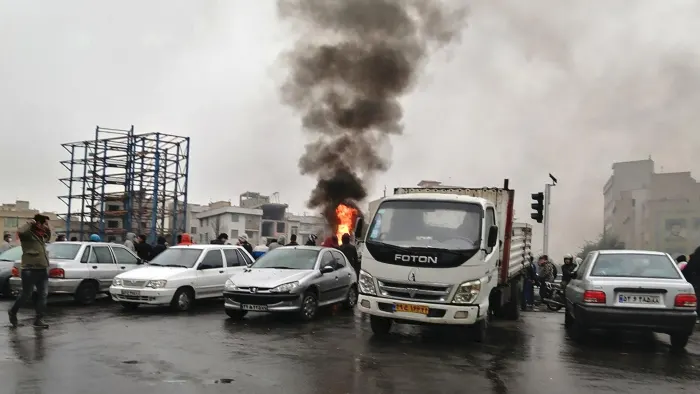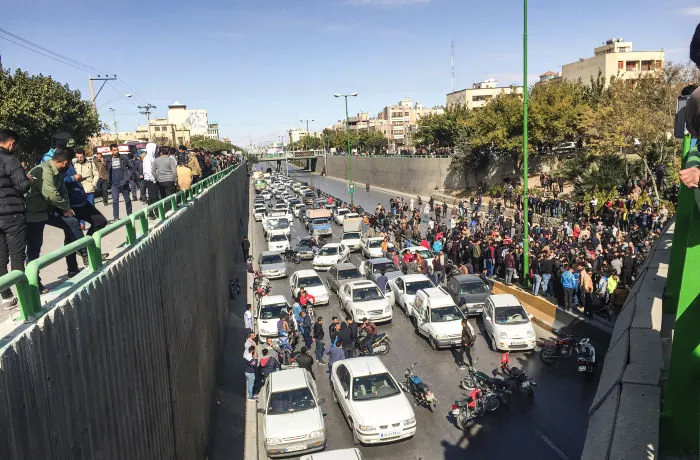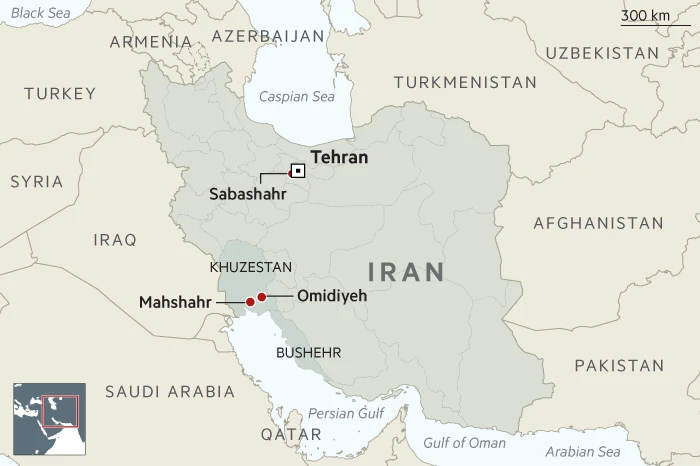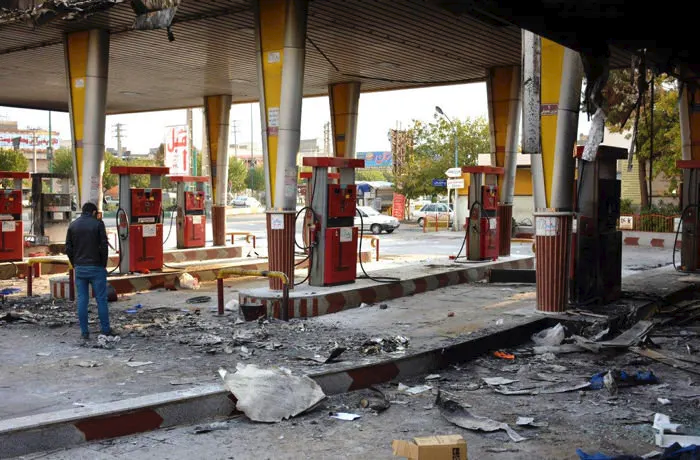
A fire breaks out during a demonstration in Tehran against an increase in petrol prices © AFP via Getty Images
Details start to emerge as information blackout is finally lifted
Dec.06.2019 –FINANCIAL TIMES – Najmeh Bozorgmehr in Tehran – Please use the sharing tools found via the share button at the top or side of articles. Copying articles to share with others is a breach of FT.com T&Cs and Copyright Policy. Email licensing@ft.com to buy additional rights. Subscribers may share up to 10 or 20 articles per month using the gift article service. More information can be found here.
For Ahmad, an unemployed 24 year-old who grew up near the vast oil wells that have for decades sustained the Islamic republic of Iran and the elite he perceives as corrupt, the decision to increase petrol prices by half was the last straw. He had never protested before but he and dozens of his friends decided to block the main roads around Omidiyeh, an oil town in south-western Iran, with burning tyres. They cut off the resource-rich province of Khuzestan from the port city of Bushehr. “There is no injustice bigger than sitting on an ocean of oil and gas and even seeing oil wells from your houses but struggling with . . . unemployment,” said Ahmad, who did not want his real name to be published. Despite his qualifications, he has struggled to get work in the state-run oil companies that are the main source of jobs in his hometown. “Petrol [price increase] was only an excuse for us to help get rid of the fire in our hearts and instead set fire to the unjust establishment.” The revolt last month in the town of 92,000 residents sparked a wave of similar protests across the country. Khuzestan was at the heart of the most violent unrest since the 1979 revolution that established the theocratic regime.

Protesters block a road in Isfahan during a demonstration on November 16 against an increase in petrol prices © AFP
Please use the sharing tools found via the share button at the top or side of articles. Copying articles to share with others is a breach of FT.com T&Cs and Copyright Policy. Email licensing@ft.com to buy additional rights. Subscribers may share up to 10 or 20 articles per month using the gift article service. More information can be found here.
https://www.ft.com/content/e5b7041c-1735-11ea-8d73-6303645ac406
More than 200 people were killed across the country, according to Amnesty International, in disturbances that rocked the political establishment and underlined the anger many young Iranians harbour against the regime. The government of Hassan Rouhani increased petrol prices last month in an effort to offset the impact of US sanctions on the government’s coffers. The government insists the worst is over but US president Donald Trump’s “maximum pressure” strategy has taken its toll. When the protests began in mid-November, the regime imposed an information blackout and shut down the internet. Details of the protests are only now starting to filter out. Hundreds of thousands of people poured into the streets of suburbs and small towns over a period of several days, according to protesters, activists and analysts. They set hundreds of banks, petrol stations, chain stores and seminaries alight. In Mahshahr, protesters hid in the reeds, only for them to be shot with live rounds. A local police chief told domestic media that “hostile groups hid there and were shooting at security forces”. “When I went to Mahshahr with a friend, we saw the city was complete mayhem,” added Ahmad. “Security forces had brought tanks and Dushka [Soviet heavy machine gun] to kill protesters.” It is unclear how many died there.

Please use the sharing tools found via the share button at the top or side of articles. Copying articles to share with others is a breach of FT.com T&Cs and Copyright Policy. Email licensing@ft.com to buy additional rights. Subscribers may share up to 10 or 20 articles per month using the gift article service. More information can be found here.
https://www.ft.com/content/e5b7041c-1735-11ea-8d73-6303645ac406
The brutal and swift crackdown made clear the regime’s willingness to suppress any domestic discontent, analysts said, not least because of the shadow cast by similar protests in Iraq and Lebanon. “This time of repression had a strong message to protesters: It should not happen again or else severe punishment awaits you,” said a reformist politician. “Revolutionaries who came to power through street protests know how to deal with street protests.” The Islamic regime, which has at its heart an ideology of serving mostaz’afin — the poor — was rocked by the extent of the anger voiced by poorer people, traditionally a bedrock of support for the regime. In a rare statement, Mir-Hossein Moussavi, an Iranian opposition leader who has been under house arrest for eight years, likened the protests to a riot that took place some months before the revolution that ushered in the Islamic state.
Please use the sharing tools found via the share button at the top or side of articles. Copying articles to share with others is a breach of FT.com T&Cs and Copyright Policy. Email licensing@ft.com to buy additional rights. Subscribers may share up to 10 or 20 articles per month using the gift article service. More information can be found here.
Many of the protesters were under 18. In Sabashahr, a suburb south-west of Tehran, a teenage boy went up a steel pole “like a cat” and brought down two banners of Ayatollah Ali Khamenei, the supreme leader, and threw them into a fire, said Ali, a 29-year-old IT engineer. He did not want his real name to be published. Most of the young people in his hometown of about 50,000 residents were out in the streets, he said. “Protesters looked fearless and had come to destroy banks which benefit the rich and petrol stations which generate income for the state,” he added. “Under the Islamic republic only 10 per cent of the population who are children of politicians and the rich can enjoy life. Our share is high debt and misery.” State authorities said protesters had been armed and trained by outside forces, including the US, Israel and Saudi Arabia. The huge natural wealth in Khuzestan province — home to the ethnic Arab minority often perceived to have separatist instincts as well as allies in Saudi Arabia — contributed to the severity of the crackdown there. “None of us got killed and only three arrested but we hear about hundreds of deaths, including security forces, only in this province,” Ahmad said. “The authorities do not easily give back corpses and even demand money [for their return].”

The wreckage of a petrol station that had been set ablaze by protesters during a demonstration in Eslamshahr near the Iranian capital of Tehran on November 17 © AFP
Please use the sharing tools found via the share button at the top or side of articles. Copying articles to share with others is a breach of FT.com T&Cs and Copyright Policy. Email licensing@ft.com to buy additional rights. Subscribers may share up to 10 or 20 articles per month using the gift article service. More information can be found here.
https://www.ft.com/content/e5b7041c-1735-11ea-8d73-6303645ac406
Ahmad and his friends blocked roads for four days in a row. But when news filtered in that their relatives had been killed by security forces, they decided to stop. “The internet was shut down and we felt it was a lonely war as we didn’t have enough information about what was happening in the rest of the country,” he said. In Tehran, Zahra, 43, said middle-class protesters did not stay long, returning home for fear of riots. “The middle class live in a bubble while worried about losing the small pleasures they have,” said Zahra, who did not want her real name to be published. “Their bigger concern during protests was their internet connection.” Back in Khuzestan, Ahmad is now more devastated than ever. “I realised protests are fruitless and too costly. The number of killings showed me that we are unable to change anything in face of a cruel system unless everyone comes out.”
